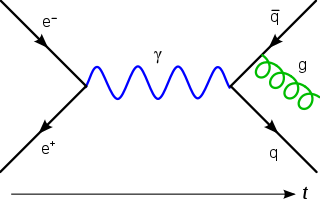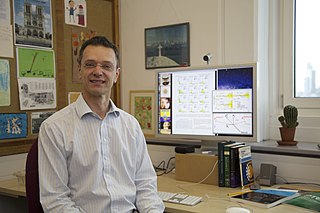Related Research Articles

A gluon is an elementary particle that acts as the exchange particle for the strong force between quarks. It is analogous to the exchange of photons in the electromagnetic force between two charged particles. Gluons bind quarks together, forming hadrons such as protons and neutrons.

The Large Hadron Collider (LHC) is the world's largest and highest-energy particle collider. It was built by the European Organization for Nuclear Research (CERN) between 1998 and 2008 in collaboration with over 10,000 scientists and hundreds of universities and laboratories, as well as more than 100 countries. It lies in a tunnel 27 kilometres (17 mi) in circumference and as deep as 175 metres (574 ft) beneath the France–Switzerland border near Geneva.

ATLAS is the largest, general-purpose particle detector experiment at the Large Hadron Collider (LHC), a particle accelerator at CERN in Switzerland. The experiment is designed to take advantage of the unprecedented energy available at the LHC and observe phenomena that involve highly massive particles which were not observable using earlier lower-energy accelerators. ATLAS was one of the two LHC experiments involved in the discovery of the Higgs boson in July 2012. It was also designed to search for evidence of theories of particle physics beyond the Standard Model.

A tetraquark, in particle physics, is an exotic meson composed of four valence quarks. A tetraquark state has long been suspected to be allowed by quantum chromodynamics, the modern theory of strong interactions. A tetraquark state is an example of an exotic hadron which lies outside the conventional quark model classification. A number of different types of tetraquark have been observed.
A collider is a type of particle accelerator which brings two opposing particle beams together such that the particles collide. Colliders may either be ring accelerators or linear accelerators.

The ISR was a particle accelerator at CERN. It was the world's first hadron collider, and ran from 1971 to 1984, with a maximum center of mass energy of 62 GeV. From its initial startup, the collider itself had the capability to produce particles like the J/ψ and the upsilon, as well as observable jet structure; however, the particle detector experiments were not configured to observe events with large momentum transverse to the beamline, leaving these discoveries to be made at other experiments in the mid-1970s. Nevertheless, the construction of the ISR involved many advances in accelerator physics, including the first use of stochastic cooling, and it held the record for luminosity at a hadron collider until surpassed by the Tevatron in 2004.
In particle physics, the parton model is a model of hadrons, such as protons and neutrons, proposed by Richard Feynman. It is useful for interpreting the cascades of radiation produced from quantum chromodynamics (QCD) processes and interactions in high-energy particle collisions.
The High Luminosity Large Hadron Collider is an upgrade to the Large Hadron Collider, operated by the European Organization for Nuclear Research (CERN), located at the French-Swiss border near Geneva. From 2011 to 2020, the project was led by Lucio Rossi. In 2020 the lead role was taken up by Oliver Brüning.

Quark–gluon plasma (QGP) is an interacting localized assembly of quarks and gluons at thermal and chemical (abundance) equilibrium. The word plasma signals that free color charges are allowed. In a 1987 summary, Léon van Hove pointed out the equivalence of the three terms: quark gluon plasma, quark matter and a new state of matter. Since the temperature is above the Hagedorn temperature—and thus above the scale of light u,d-quark mass—the pressure exhibits the relativistic Stefan-Boltzmann format governed by temperature to the fourth power and many practically massless quark and gluon constituents. It can be said that QGP emerges to be the new phase of strongly interacting matter which manifests its physical properties in terms of nearly free dynamics of practically massless gluons and quarks. Both quarks and gluons must be present in conditions near chemical (yield) equilibrium with their colour charge open for a new state of matter to be referred to as QGP.

NA61/SHINE is a particle physics experiment at the Super Proton Synchrotron (SPS) at the European Organization for Nuclear Research (CERN). The experiment studies the hadronic final states produced in interactions of various beam particles with a variety of fixed nuclear targets at the SPS energies.

MoEDAL is a particle physics experiment at the Large Hadron Collider (LHC).
A Muon Collider is a proposed particle accelerator facility in its conceptual design stage that collides muon beams for precision studies of the Standard Model and for direct searches of new physics. Muons belong to the second generation of leptons, they are typically produced in high-energy collisions either naturally or artificially. The main challenge of such a collider is the short lifetime of muons.

Terence Richard Wyatt is a Professor in the School of Physics and Astronomy at the University of Manchester, UK.

The Future Circular Collider (FCC) is a proposed particle accelerator with an energy significantly above that of previous circular colliders, such as the Super Proton Synchrotron, the Tevatron, and the Large Hadron Collider (LHC). The FCC project is considering three scenarios for collision types: FCC-hh, for hadron-hadron collisions, including proton-proton and heavy ion collisions. FCC-ee, for electron-positron collisions, and FCC-eh, for electron-hadron collisions.
Stephanie A. Majewski is an American physicist at the University of Oregon (UO) researching high energy particle physics at the CERN ATLAS experiment. She worked as a postdoctoral research associate at the Brookhaven National Laboratory prior to joining the faculty at UO in 2012. She was selected for the Early Career Research Program award of the U.S. Department of Energy (DOE), one of 35 scientists in all DOE-supported fields to receive this national honor in 2014.

The 750 GeV diphoton excess in particle physics was an anomaly in data collected at the Large Hadron Collider (LHC) in 2015, which could have been an indication of a new particle or resonance. The anomaly was absent in data collected in 2016, suggesting that the diphoton excess was a statistical fluctuation. In the interval between the December 2015 and August 2016 results, the anomaly generated considerable interest in the scientific community, including about 500 theoretical studies. The hypothetical particle was denoted by the Greek letter Ϝ in the scientific literature, owing to the decay channel in which the anomaly occurred. The data, however, were always less than five standard deviations (sigma) different from that expected if there was no new particle, and, as such, the anomaly never reached the accepted level of statistical significance required to announce a discovery in particle physics. After the August 2016 results, interest in the anomaly sank as it was considered a statistical fluctuation. Indeed, a Bayesian analysis of the anomaly found that whilst data collected in 2015 constituted "substantial" evidence for the digamma on the Jeffreys scale, data collected in 2016 combined with that collected in 2015 was evidence against the digamma.

FASER is planned to be one of the eight particle physics experiments in 2022 at the Large Hadron Collider at CERN. It is designed to both search for new light and weakly coupled elementary particles, and to study the interactions of high-energy neutrinos.
David M. Strom is an experimental high energy particle physicist on the faculty of the University of Oregon.
James Lewis Pinfold is a British-Canadian physicist, specializing in particle physics.
References
- ↑ Perl, Martin (16 Feb 2001). "The search for stable, massive, elementary particles". International Journal of Modern Physics A. 16 (12): 2137–2164. arXiv: hep-ex/0102033 . Bibcode:2001IJMPA..16.2137P. doi:10.1142/S0217751X01003548. S2CID 11571338 – via World Scientific.
- 1 2 Fairbairn, M.; Kraan, A.C.; Milstead, D.A.; Sjöstrand, T.; Skands, P.; Sloan, T. (1 January 2007). "Stable massive particles at colliders". Physics Reports. 438 (1): 1–63. arXiv: hep-ph/0611040 . Bibcode:2007PhR...438....1F. doi:10.1016/j.physrep.2006.10.002. S2CID 14872649.
- ↑ Heinrich, Jochen Jens (2014-11-27). Search for charged stable massive particles with the ATLAS detector (PhD thesis). Ludwig Maximilian University of Munich. Retrieved 2021-05-24.
- ↑ Mehlhase, Sascha (2017). "Search for Stable Massive Particles with the ATLAS detector in proton–proton collisions at √s = 13 TeV". Proceedings of 38th International Conference on High Energy Physics. Proceedings of Science. Vol. 282. Chicago, USA. p. 1119. doi: 10.22323/1.282.1119 .
- ↑ Felea, D.; Mamuzic, J.; Masełek, R.; Mavromatos, N. E.; Mitsou, V. A.; Pinfold, J. L.; de Austri, R. Ruiz; Sakurai, K.; Santra, A.; Vives, O. (2020). "Prospects for discovering supersymmetric long-lived particles with MoEDAL". The European Physical Journal C. 80 (5): 431. arXiv: 2001.05980 . Bibcode:2020EPJC...80..431F. doi: 10.1140/epjc/s10052-020-7994-7 . PMC 7231802 . PMID 32440256.
- ↑ Burdin, Sergey; Fairbairn, Malcolm; Mermod, Philippe; Milstead, David; Pinfold, James; Sloan, Terry; Taylor, Wendy (2015). "Non-collider searches for stable massive particles". Physics Reports. 582: 1. arXiv: 1410.1374 . Bibcode:2015PhR...582....1B. doi:10.1016/j.physrep.2015.03.004. S2CID 118333394.
{{cite journal}}: CS1 maint: url-status (link)